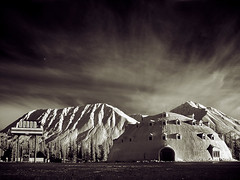There’s no real iconic building in Los Angeles. The city’s symbol, if one exists, is the
“Hollywood” sign, built atop Mount Cahuenga in the 1920s to flog a real estate development. I first visited LA in the late 1970s, touring by city bus, always amazed when the sign would reveal itself to me. It still holds a sense of wonder, many years later: a graphical sign looming above the city.
During interleague play (over the weekend of the 20-22 May), Goff and I saw the
Los Angeles Angels of Anaheim take on the Dodgers in
Dodger Stadium,
my first visit to the storied ballpark. The cheap seats were a lot more entertaining than attending an Orioles game at
Camden Yards, especially for the surprisingly contentious rivalry: the largely Latino crowd (with entire families dressed in Dodger Blue or Angel Red—did the Angels’ brain trust know what they were doing when they tacked
Bloods to the Dodgers’
Crips?) was vocal and good-natured, jeering the opposition throughout the tautly-played game.
When Eric Gagné—recently returned from the DL—entered the game in the ninth, the entire stadium blasted off. In the shadow of the left-field “
THINK BLUE” sign, though, the Dodger offense would not prevail.
If you spend any time driving about the American west, one will come across
monograms,
spelled-out in white stone, on mountains and hillsides above town. These signs largely date from 1905-1915, and were constructed by students from high schools and colleges to trumpet school and/or class spirit (the original is apparently Cal’s “
Big ‘C’” on the Berkeley hills, as documented in 1988 by James Parsons in
Landscape, v. 30, no. 1, and reprinted
here).
For those who yearn for the east coast to get into the act, check out the
Murrysville tree sign, a Pennsylvania herald fashioned by planting fir trees spelling out the town name in a clearing, a sign that's
still visible.
Labels: baseball, design, LA, wonder















































